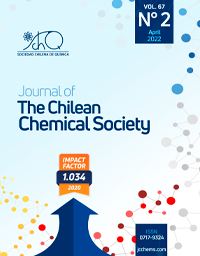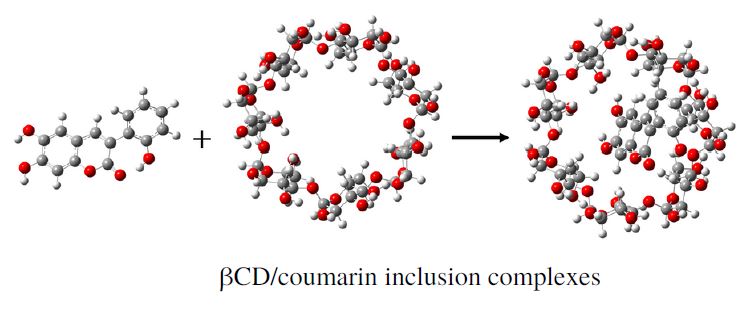THERMODYNAMIC AND REACTIVITY ASPECT OF β-CYCLODEXTRINE INCLUSION COMPLEXES WITH COUMARIN DERIVATIVES

- Docking Coumarin β-Cyclodextrin Reactivity Thermodynamic
Copyright (c) 2022 SChQ

This work is licensed under a Creative Commons Attribution-NonCommercial-ShareAlike 4.0 International License.
Abstract
In this study, the thermodynamic and reactivity characteristics of coumarin-derived ligand inclusion complexes with βCD were described, in addition to the in situ reactivity of these ligands and their changes in the complex cavity. For this purpose, computational tools such as molecular docking, second order perturbative analysis (E2PERT), ONIOM2 (DFT/PM6) methods were employed to obtain the global and local reactivity indices, and thermodynamic parameters, in addition to non-covalent interaction (NCI) analysis. As a result, it can be observed that the inclusion complexes are stable and viable given the ability to form non-covalent interactions, but their formation is not spontaneous under the modeling conditions. The global and local reactivity indices show that the ligands change their chemical reactivity inside the inclusion complex, demonstrating that the studied ligands present AOX SET activity outside the cavity, and HAT activity inside the cavity, mainly the C1 and C3 ligands.
References
2. G. Kirsch, A. Abdelwahab, P. Chaimbault, Natural and Synthetic Coumarins with Effects on Inflammation. Molecules, 21(10), 1322. (2016)
3. I. Kostova, S. Bhatia, P. Grigorov, S. Balkansky, S. Parmar, V. K. Prasad, & L. Saso. Coumarins as Antioxidants. Current Medicinal Chemistry, 18(25), 3929–3951. (2011)
4. T. Verhoef, W. Redekop, A. Daly, R. van Schie, A. de Boer, A. Maitland-van der Zee. Pharmacogenetic-guided dosing of coumarin anticoagulants: algorithms for warfarin, acenocoumarol and phenprocoumon. British Journal of Clinical Pharmacology, 77(4), 626–641. (2014)
5. F. Pérez-Cruz, S. Serra, G., Delogu, M. lapier, J. Maya, C. Olea-Azar, Santana, E. Uriarte. antitrypanosomal and antioxidant properties of 4-hydroxycoumarins derivatives. bioorganic & medicinal chemistry letters, 22(17), 5569 – 5573. (2012)
6. J. Szejtli. Past, present and future of cyclodextrin research. Pure and Applied Chemistry, 76(10), 1825–1845. (2004)
7. T. Loftsson, D. Duchene. Cyclodextrins and their pharmaceutical applications. International Journal of Pharmaceutics, 329(1-2), 1–11. (2007)
8. C. Grégori. Review: A History of Cyclodextrines. Chemical Review, 114 (21), 10940 – 10975. (2014)
9. K. Connors. The Stability of Cyclodextrin Complexes in Solution. Chemical Reviews, 97(5), 1325–1358. (1997)
10. A. Radi, S. Eissa. Electrochemistry of cyclodextrin inclusion complexes of pharmaceutical compounds. Open Chemical and Biomedical Methods Journal, 3, 74 – 85. (2010)
11. M. R. Nora, L. Ismahan, G. Abdelkrim, C. Mouna, N. Leila, M. Fatiha, B. Nada, H. Brahim. Interactions in inclusion complex of β-cyclodextrin/l-Metheonine: DFT computational studies. Journal of Inclusion Phenomena and Macrocyclic Chemistry, 96, 43 – 54. (2019)
12. S. K. Xing, C. Zhang, H. Ai, Q. Zhao, Q. Zhang, D. Sun. Theoretical study of the interactions of β-cyclodextrin with 2′-hydroxyl-5′-methoxyacetophone and two of its isomers. Journal of Molecular Liquids, 146(1-2), 15 – 22. (2009)
13. F. D’Aria, B. Pagano, C. Giancola. Thermodynamic properties of hydroxypropyl-β-cyclodextrin/guest interaction: a survey of recent studies. Journal of Thermal Analysis and Calorimetry. (2021)
14. P.D. Ross, M. V. Rekharsky. Thermodynamics of hydrogen bond and hydrophobic interactions in cyclodextrin complexes. Biophysical Journal, 71(4), 2144 – 2154. (1996)
15. Á. Vidal Vidal, L. de Vicente Poutás, O. Nieto Faza, C.S. López. On the Use of Popular Basis Sets: Impact of the Intramolecular Basis Set Superposition Error. Molecules, 24(20), 3810. (2019)
16. F. B. Van Duijneveldt, J. G. van Duijneveldt-van de Rijdt, J. H. van Lenthe. State of the Art in Counterpoise Theory. Chemical Reviews, 94(7), 1873 – 1885. (1994)
17. A. Reed, L. Curtiss, F. Weinhold. Intermolecular interactions from a natural bond orbital, Donor – acceptor viewpoint. Chemical Reviews, 88(6), 899 – 926. (1988)
18. B.D. Dunnington, J. R. Schmidt, J. R. Generalization of Natural Bond Orbital Analysis to Periodic Systems: Applications to Solids and Surfaces via Plane-Wave Density Functional Theory. Journal of Chemical Theory and Computation, 8(6), 1902–1911. (2012)
19. E.D. Glendening, C.R. Landis, F. Weinhold. Natural bond orbital methods. Wiley Interdisciplinary Reviews: Computational Molecular Science, 2(1), 1 – 42. (2011)
20. T. Lu, & F. Chen. Multiwfn: A multifunctional wavefunction analyzer. Journal of Computational Chemistry, 33(5), 580–592. (2011)
21. M. Farrokhnia. Density Functional Theory Studies on the Antioxidant Mechanism and Electronic Properties of Some Bioactive Marine Meroterpenoids: Sargahydroquionic Acid and Sargachromanol. ACS omega, 5(32), 20382–20390. (2020)
22. V.K. Rajan, K. Muraleedharan. A computational investigation on the structure, global parameters and antioxidant capacity of a polyphenol, Gallic acid. Food Chemistry, 220, 93 – 99. (2017)
23. L.C. Balbás, J.A. Alonso, L.A. Vega. Density functional theory of the chemical potential of atoms and its relation to electrostatic potentials and bonding distances. Z Phys D - Atoms, Molecules and Clusters 1, 215–221 (1986)
24. S. Figueredo, M. Páez, F. Torres. índices de poder electrofílico global y local para el estudio teórico de la reactividad química: aplicación a derivados carbonilo α, β-insaturados. Química Nova, 40(5), 513 – 522. (2017)
25. V.P. Gupta. Characterization of Chemical Reactions. Principles and Applications of Quantum Chemistry, 385–433. (2016)
26. R.G. Parr, L. Szentpály, S. Liu. Electrophilicity Index. Journal of the American Chemical Society, 121(9), 1922–1924. (1999)
27. R.G. Parr, W. Yang. Density Functional Approach to the Frontier - Electron Theory of Chemical Reactivity, Journal of the American Chemical Society 106. 4049 – 4050. (1984)
28. C. Morell, A. Grand, A. Toro-Labbé. New dual descriptor for chemical reactivity. Journal of Physical Chemistry A 109, 205–212. (2005)
29. M. J. Frisch, G. W. Trucks, H. B. Schlegel, G. E. Scuseria, M. A. Robb, J. R. Cheeseman, G. Scalmani, V. Barone, B. Mennucci, G. A. Petersson, H. Nakatsuji, M. Caricato, X. Li, H. P. Hratchian, A. F. Izmaylov, J. Bloino, G. Zheng, J. L. Sonnenberg, M. Hada, M. Ehara, K. Toyota, R. Fukuda, J. Hasegawa, M. Ishida, T. Nakajima, Y. Honda, O. Kitao, H. Nakai, T. Vreven, J. A. Montgomery, Jr., J. E. Peralta, F. Ogliaro, M. Bearpark, J. J. Heyd, E. Brothers, K. N. Kudin, V. N. Staroverov, R. Kobayashi, J. Normand, K. Raghavachari, A. Rendell, J. C. Burant, S. S. Iyengar, J. Tomasi, M. Cossi, N. Rega, J. M. Millam, M. Klene, J. E. Knox, J. B. Cross, V. Bakken, C. Adamo, J. Jaramillo, R. Gomperts, R. E. Stratmann, O. Yazyev, A. J. Austin, R. Cammi, C. Pomelli, J. W. Ochterski, R. L. Martin, K. Morokuma, V. G. Zakrzewski, G. A. Voth, P. Salvador, J. J. Dannenberg, S. Dapprich, A. D. Daniels, Ö. Farkas, J. B. Foresman, J. V. Ortiz, J. Cioslowski, and D. J. Fox, Gaussian 09, Revision E. 01, Gaussian, Inc., Wallingford CT. (2013)
30. J.D. Chai, M. Head-Gordon. Long-range corrected hybrid density functionals with damped atom–atom dispersion corrections. Physical Chemistry Chemical Physics, 10(44), 6615. (2008)
31. M. Adachi, B. Mikami, T. Katsube, S. Utsumi. Crystal Structure of Recombinant Soybean β-Amylase Complexed with β-Cyclodextrin. Journal of Biological Chemistry, 273(31), 19859 – 19865. (1998)
32. G.M. Morris, R. Huey, W. Lindstrom, M.F. Sanner, R.K. Belew, D.S. Goodsell, A.J. Olson. AutoDock4 and AutoDockTools4: Automated docking with selective receptor flexibility. Journal of Computational Chemistry, 30(16), 2785 – 2791. (2009)
33. E. Faúndez. Efecto de dimetil – β – ciclodextrina en la interacción de moléculas heterocíclicas con ADN y metales de transición de importancia biológica. Repositorio Universidad de Chile. Facultad de Ciencias Químicas y Farmaceuticas. (2016)
34. L.W. Chung, W.M.C. Sameera, R. Ramozzi, A.J. Page, M. Hatanaka, G.P. Petrova, K. Morokuma. The ONIOM Method and Its Applications. Chemical Reviews, 115(12), 5678–5796. (2015)
35. E. Glendening, J. Badenhoop, A. Reed, J. Carpenter, C. Bohmann, C. Morales, C. Landis, F. Weinhold. NBO 6.0: Natural Bond Orbital analysis program. Journal of Computational Chemistry, 34(16), 1429 – 1437. (2013)
36. K. Sahra, K. Dinar, A. Seridi, M. Kadri. Investigation on the inclusion of diclofenac with β-cyclodextrin: a molecular modeling approach. Structural Chemistry, 26(1), 61 – 69. (2015)
37. W. Humphrey, A. Dalke, K. Schulten. "VMD - Visual Molecular Dynamics", Journal of Molecular Graphics, 14, 33 – 38. (1996)
38. R. Contreras, P. Fuentealba, M. Galván, P. Pérez. Chemical Physical Letters. 304(5-6), 405-413. (1999)
39. P. Fuentealba, P. Pérez, R. Contreras. Journal of Chemical Physics 113(7), 2544-2551. (2000)
40. S. Y. Huang, X. Zou, X. Advances and Challenges in Protein-Ligand Docking. International Journal of Molecular Sciences, 11(8), 3016 – 3034. (2010)
41. L. Ismahan, N. Leila, M. Fatiha, G. Abdelkrim, C. Mouna, B. Nada, H. Brahim, H. Computational study of inclusion complex of l-Glutamine/beta-Cyclodextrin: Electronic and intermolecular interactions investigations. Journal of Molecular Structure, 127740. (2020)
42. M.E. Davis, M.E. Brewster. Cyclodextrin-based pharmaceutics: past, present and future. Nature Reviews Drug Discovery, 3(12), 1023 – 1035. (2004)
43. T. Li, R. Guo, Q. Zong, G. Ling. Application of molecular docking in elaborating molecular mechanisms and interactions of supramolecular cyclodextrin. Carbohydrate Polymers, 118644. (2021)
44. P.D. Ross, M.V. Rekharsky. Thermodynamics of hydrogen bond and hydrophobic interactions in cyclodextrin complexes. Biophysical Journal, 71(4), 2144 – 2154. (1996)
45. M.V. Rekharsky, Y. Inoue. Complexation thermodynamics of cyclodextrins. Chemical reviews, 98(5), 1875 – 1918. (1998)
46. F. Biedermann, W.M. Nau, H.J. Schneider. The Hydrophobic Effect Revisited – Studies with Supramolecular Complexes Imply High – Energy Water as a Noncovalent Driving Force. Angewandte Chemie International Edition, 53(42):11158 – 11171. (2014)
47. A. Fifere, N. Marangoci, S. Maier, A. Coroaba, D. Maftei, M. Pinteala. Theoretical study on β-cyclodextrin inclusion complexes with propiconazole and protonated propiconazole. Beilstein Journal of Organic Chemistry, 8, 2191–2201. (2012)
48. I. Fleming. Orbitales moleculares y reacciones de química orgánica. 1era Edición. Editorial Wiley. Cap. 3. pp. 127 – 143. (2010)
49. R. Parr, W. Yang. Density - Functional Theory of Atoms and Molecules, Chapter 4. Oxford University Press: New York. Ca. (1989)
50. R. Parr, R. Donnelly, M. Levy, W. Palke. Electronegativity: the density functional viewpoint. Journal of Chemical Physical, 68, 3801. (1978)
51. R.P. Iczkowski, J. L. Margrave. Electronegativity. Journal of the American Chemical Society, 83(17), 3547 – 3551. (1961)
52. R.G. Pearson. Chemical Hardness: Aplications from Molecules to Solids, Wiley-VCH Verlag GMBH: Weinheim. Chapter 4. pp. 99-124. (1997)
53. K. Pérez-Cruz, M. Moncada - Basualto, J. Morales-Valenzuela, G. Barriga - González, P. Navarrete-Encina, L. Núñez - Vergara, J.A. Squella, C. Olea-Azar. Synthesis and antioxidant study of new polyphenolic hybrid - coumarins. Arabian Journal of Chemistry, 11(4), 525–537. (2018)


